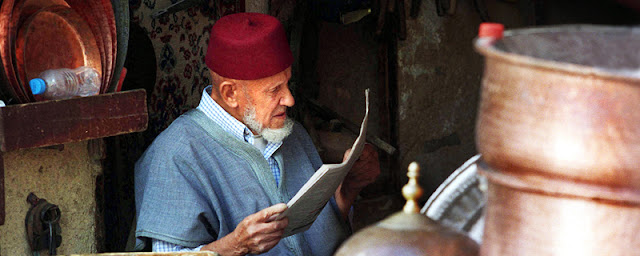The View from Fez looks at some criticisms of the Fes Festival - some old chestnuts and some more recent points of view.

The Fes Festival of World Sacred Music was established 16 years ago by Sufi scholar Faouzi Skali as a direct response to the first Gulf War. Skali felt that world peace could be enhanced by the harmony engendered by music.
For the first festival in 1994, musicians from the three Abrahamic faiths - Judaism, Christianity and Islam - were invited to play in Fez. Since those early years, the festival has grown to include musicians from other religions and belief systems: Hinduism, Tibetan Buddhism, Shintoism and shamans from various countries have been represented.
Is it spiritual?
One of the criticisms levelled at the festival is that some of the music is simply not 'spiritual'. While you can easily see the spirituality embodied in, for example, Christian Gospel music, can Spanish Flamenco be considered 'spiritual music'? Just because Ismael Lo is a member of the Tijania Sufi brotherhood, does this make his music 'spiritual'? And likewise in this year's programme, what's 'spiritual' about Ben Harper's music? Does his philanthropic espousal of worthy causes make his music 'spiritual'?
 Aissawa Brotherhood
Aissawa Brotherhood
On a practical level, there have to be world-renowned artists at the festival to put bums on seats. Diverse performances will attract a larger crowd, festival music programming head Zineb Lemrabet said.
"During the festival, we offer a mix of musical genres to attract the largest number of people," she explained.
Lemrabet went on to say that "The spiritual essence is present in all types of music that we offer. Even rock music has that essence, as does rap - for example, the song 'Aissawa Style' by Moroccan group H-Kayne, which saw much success at the festival."
"It is also present in popular Moroccan music, as evidenced by the name of God and prayer to the Prophet Mohammad (peace be upon him) in many of the lyrics," Lemrabet added. "For me, what shows the presence of a spiritual essence is the audience's interaction with the singer."
"The call for tolerance is found at all festival performances," she said, "and everyone must broaden their intellectual horizons to receive that call."
Is it Moroccan?
 Samira Kadiri and Esperanza Fernandez
Samira Kadiri and Esperanza Fernandez
An oft-heard complaint is that few Moroccan artists are involved in the festival. The event has grown to include more international acts in recent years at the expense of Moroccan artists, according to critics.
"We have reservations as Maghreb artists with regard to the organisers' failure to take interest in Moroccan art, and we question the reason for the severe lack of Maghreb artists within the activities of a festival that is originally from Morocco," Moroccan composer Aziz Hosni said.
"We are proud there is a festival of this scale aiming to foster a culture of tolerance and religious co-existence and working to give Morocco a good image, and that many foreigners have paid to get to know the country," Hosni said.
The event may have lost its local focus with its growing success, however. The organisers have failed to involve local organisations, said Noureddine Mosaid, who serves as assistant president for the Fez-based Sabil Association.
"The festival targets the elite, and there is an absence of cultural involvement in events in the city, so we don't participate in developing its programme," he said.
Spirit of Fez President Mohamed Kabbaj defended the festival.
"If you look at the programme as a whole, we find it contains 90 percent Maghreb artists," he said. The events that lack Moroccan art, such as those at the Batha Museum and Bab el Makina venues, are private and charge an admissions fee, he said.
"The reason stems from wanting to make it more open to the cultures of different people and to not be dominated by a particular culture," Kabbaj said.
This year's festival features Moroccan Ahmed Essyad performing with the French ensemble Accroche Note on the afternoon of 7 June at the Batha Museum. There are some other artists from the Maghreb. It should be noted, too, that the majority of artists performing in the Festival in the City are Moroccan, including a number of Sufi brotherhoods.
Is it elitist?
Programming during the first few years of the festival was certainly elitist as most Moroccans couldn't - and still can't - afford a ticket to events at Bab el Makina (this year costing from Dh150-500).
However, in recent years there has been a Festival in the City running at the same time at the expensive events at the Batha Museum and Bab el Makina. Free concerts are held each day at 18h00 at Place Boujloud, at 20h00 at Ait Skato in the new city, and at 23h00 at Dar Pacha Tazi. There are also free exhibitions. This embraces the people of Fez who otherwise would not be able to enjoy the music on offer at this major event.
The Festival runs from 4-12 June.
See the programme
here.












